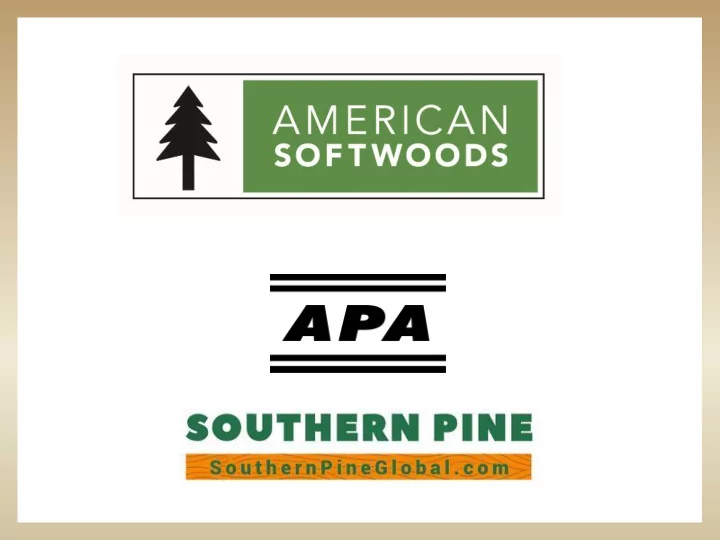

Southern Pine Lumber
Growing Region • 110 Million Hectares • 197 • 4318.8 M 3 • 232 Million Acres • 197 SYP Sawmills • 18.3 BBF Capacity
• Southeast produces 60% of the lumber products from USA. • The lumber crops have raised 17% since 1980
Sustainable Forestry 2 nd Thinning Final Harvest Planting 1 st Thinning
Lumber Characteristics When wood absorbs water, As it dries, it swells wood shrinks
Southern Yellow Pine Characteristics High Strength Dried to 19% MC Superior Nailholding Durability Treatability Density Resistant Sustainability
Why SYP is so good? In most cases, it is stronger than other lumber species. Different lenght and widnesses available. Grades and fiber quality allow wider lights distances in the construction. Fiber quality and Grades allow to use it in more efficient constructions.
Lumber Grades
Uses and Lumber Grades Lumber grades – they divide in three basic clasifications: 1. Appereance and Utility grades 2. Re-manufacturing grades and industrial uses. 3. Structural Lumber Grades
Characteristics • Slope of Grain • Knots • Decay • Splits • Wane • Warp • Skip • Checks
Knots • The portion of a branch that has become incorporated in the bole (stem/trunk) of a tree. • Knots interrupt the continuity and change in the direction of wood fibers.
Characteristics determine the lumber grade • Large Knots Wane Many Knots = Lower Grade • Smaller Knots Few Knots = Higher Grade
The grade determine the value • Lower Grade = Weaker = More Blemished • Higher Grade = Stronger = Nearly Clear
KD ꞊ HT
Lumber Dimensions Thicknesses 1” to 1½” Boards 2” to 4” Dimensioned 5” + Lumber
Appearance products • Typically 1” Thick • Not for Structural Use • Surfaced Four Sides • Dried to 15% or less • Siding • Flooring • Paneling
Appearance products
Furniture
Doors and Windows
Structural Grades • Typically 2” Thick • Structural Use • Surfaced Four Sides • Known design values • Dried to 19% • Dimension Lumber • • 2x4 through 2x12 • 4x4 • Joists, Rafters, Beams, Studs, Planks • Timbers • 5 in. and larger
Structural Grades Posts (6x6) Beams Joists Wall Studs
Structural Grades Floor Systems
Structural Grades Roof Systems
Kiln drying Lumber • Stability • Increased Strength • Lower Weight • Enhances Appearance • Finishes Better • Required for Proper Pressure Treatment
Lumber – Treated Lumber
¿What is the treated lumber? Provide long term protection against the rot of the lumber, fungus and termites. Have been developed to protect the lumber products that are exposed to outdoors and increase the life span of the lumber products. The treated lumber have the same resistant values for structural uses as well as the treated lumber The lumber color could change
Most Common Lumber Treatments Treatments water and cupper base : Cupper Base • ACQ – Alkaline Copper Quat • ACZA – Ammonical Copper Zinc Arsenate • CA – Copper Azole • CCA – Chromated Copper Arsenate • MCA – Micronized Copper Azole
Inside the treatment cylinder Step 1 Dry wood is loaded into cylinder
Inside the treatment cylinder Step 2 Initial vacuum pulls out air
Inside the treatment cylinder Step 3 Liquid preservative fills cylinder
Inside the treatment cylinder Step 4 Pressure forces preservative into wood
Inside the treatment cylinder Step 5 Remaining liquid emptied for later use
Inside the treatment cylinder Step 6 Final vacuum removes excess chemical
Applications • STRUCTURAL • Joists, Beams, Posts • Trusses & Glulam Beams • Sill Plate • Decking • Permanent wood foundations • Gazebos • NON-STRUCTURAL • Furniture • Windows • Fences • Landscape & Garden • Roofing (shakes/shingles)
Commercial Applications • Walkways • Structural columns • Exterior stairways • Utility poles • Building poles • Piling (foundation & marine) • Guardrail posts • Sign posts • Retaining walls
Applications
• www.SouthernPineGlobal.com • www.SouthernPine.com
Questions? María Fernanda Vale AMSO México, the Caribbean & Latin America Consultant fernanda.vale@softwood.com.mx info@softwood.com.mx Tel. +52 (55) 4151 2107/08 www.americansoftwoodsmexico.com
Recommend
More recommend